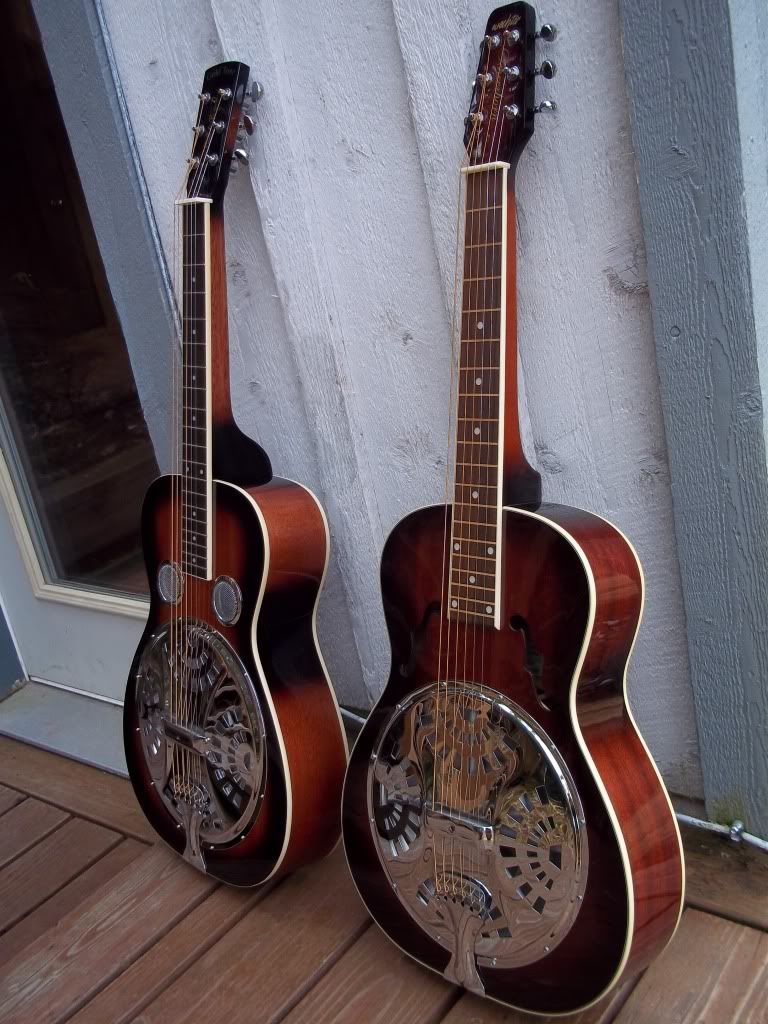|
Haven't seen any Resonator or Slide Guitars yet so I'll go ahead.  In the 1920's people were trying to find a way to amplify acoustic guitars. Several attempts were made with varying degrees of success. Around 1928 or so (no one knows the exact date) a pair of brothers named John and Rudolph Dopyera who had recently immigrated from Czechoslovakia came up with several patents using spun aluminum cones in the body of the guitar that acted as mechanical speakers. Their first design used an inverted cone with a wooden biscuit in the middle which held the saddle. The cone sat under a metal coverplate and the vibrating strings caused the thin cone to resonate. Later they came up with the idea of using metal bodies and three smaller cones attached by a metal T bridge. This is what we now know as the National Resophonic guitar. These early guitars were very popular in the beginning and business differences at the National Guitar company led the brothers to leave and start a new company using their new improved design. The new guitar featured an even larger cone but instead of using a biscuit or t bridge they designed an eight legged spider bride that gripped the cone in the middle and also touched the outer rim with each leg. The new design was much louder than before. The new company was named Dobro, a combination of Dopyera and Brothers, and also the Czech word for good. Several other companies caught on and up until World War Two the dobro was a premier player in Hawaiian music. After the war electric lap steel guitars could deliver even more power and the resonator guitar sort of fell by the wayside. In the 1960's and 70's a few independent luthiers began building fine custom made guitars using exotic tone woods. Players like Jerry Douglas and Rob Ickes grew up around this time and took the instrument to where it is today. Because of their high action( on square neck versions) a metal bar must be used to effectively create a fretted position on the strings. Because the slide can move anywhere on the string it allows an unlimited array of tones. The downside is that certain chords can not be played and open tunings must be used. Standard tuning from low to high is Open G (GBDGBD) but Open D ( DADF#AD) and Open E (EBEG#BE) are also very popular. Here's what the dobro sounds like at the very height of perfection. Jerry Douglas is using Open D tuning here. http://www.youtube.com/watch?v=gukFvG8VbK4 Here's an awesome sound clip also in Open D: http://www.harper-resophonics.com/downloads/music/StyleA-007_demo.mp3 Disclaimer: If you're going to try the next two tunings on a regular round neck guitar with raised action you might want to consider some heavier resonator strings as regular acoustics might not handle the stress. Also these tunings will add a lot more stress than regular (EADGBE) tuning so if you notice your guitar making sounds of pain or otherwise telling you to stop then Open D might be your best bet. Here is Open E, which is a step above Open D: http://www.youtube.com/watch?v=9Fnilr40QDs Finally Open G which is standard Dobro tuning sounds like this: http://www.youtube.com/watch?v=Tk0hzDRehAE Most stuff you hear on the Dobro will be in open G, if it sounds real low and bluesy it is most likely Open D. As a fairly new player I can tell you that after a few months of listening you will be able to pick put the different keys and tunings, the undrstanding of the instrument increases immensely once you get to this point. Also if that Metal/Wood sound doesn't capture your ears and leave you wanting more then you are probably deaf. Edit: Per TTFA's request here are some price levels for dobros. If you want to go super low you can do what I did when I started out and take your little sisters busted up ovation and make a new nut out of some wood you found in your dads basement. I used a 45-70 cartridge as a slide and surprisingly it sounded ok. Any guitar can become a lap slide guitar simply by raising the action. My next guitar was a Johnson 14 fret round neck I found at a pawn shop. I can't speak for all Johnsons but the one I had sounded quite good to my beginner ears. You can buy aluminum nut extenders for like $10. If you want to start out with a resonator there are plenty of new ones to be had in the $100-$300 range. I went a step further with my next guitar and got the one on the left in the photo. Its a Gold Tone Paul Beard signature and they run around $650 new. I actually have it listed in SA mart right now for $500. Other guitars in that price range are the Wechter/Scheerhorn line, Regal, Morrell and if you look around you can find real Dobros made by OMI for around 6-700 dollars. I own a Wechter also and the interior design is totally different that the Gold Tone so they sound quite different. A good setup makes a surprising amount of difference. My Gold Tone was set up by a little man in China and sounds pretty good after I took it apart corrected some obvious oversights in the original setup, but my Wechter was actually set up by Tim Scheerhorn (whose handmade guitars sell in the $10,000 range) and everyone who has heard it is blown away. Most people are perfectly happy with these guitars and never go higher but these are basically starter instruments. For not a whole lot more though you can find some of the independent Luthiers models. I just picked up a McKenna which is a luthier instrument made from solid walnut with a spruce top for $1000. The guitars Jerry Douglas and Rob Ickes play can be had for around $7500. N183CS fucked around with this message at 07:07 on Jun 29, 2011 |
|
|
|

|
| # ¿ Apr 27, 2024 21:19 |
|
If someone who already plays electric guitar were looking at getting into lap slide they could do the raised nut thing and basically have an electric lap steel. As far as slides go I use a Dunlop Lap Dawg which has very sharp ends and is useful for pull offs where you snap it away from the string and end up with a quick changeover from a fretted note to the open string. For most playing I use a Shubb bar because it fits my hand nicely. I've found that any bar that sits in my hand and stops just before the tip of my ring finger works well. Each slide has different finger groove lengths to fit different sized hands. They can be had for around $25 new but ebay usually has good deals. Different materials make different sounds, I've seen glass, chrome steel, stainless steel, glazed clay etc. Finger picks are just as personal. I like propik nickel plated brass finger picks with two finger bands and dunlop zookies thumb picks. I've tried Alaska Picks, which slip over your finger and under your nail to basically extend it and Fred Kelly speed picks which are made for banjo players. The Hawaiian lap guitar is also known as a Weissenborn, after its creator. They are usually made of thin tone wood, usually koa and have some pretty elaborate bracing going on inside. Standard tuning for them is open D (DADF#AD) and you can play everything from gritty delta blues with lots of turnarounds to melodic celtic stuff. That Mohan Veena is pretty cool. I exchanged some emails with one of my favorite dobro players, Billy Cardine, the other day and he is playing a lot of amazing stuff on a Chaturangui. It's a lot like a Mohan Veena, with a bunch of sympathetic strings but it has even more of them. I have no idea how they work but they sound neat, maybe that could be your next weird instrument write up. Edit for string info: They do make strings specifically for resonator guitars, I think the outer windings are different material to absorb being slid on more easily. I have noticed with regular acoustic strings that they seem to have more of a brass colored winding while every set of reso strings I have had uses bronze outer windings. If you go the cheap guitar route, I would go ahead and throw new strings on as well. My first guitar had rusty old strings and the bar would hit every one of the pits in the steel and it would make an awful sound. Strings are like $5-7 anyway so why not treat yourself. My electric lap steel guitar uses steel wound strings but I think thats more for the purpose of helping the electric pickup than anything else. N183CS fucked around with this message at 20:32 on Jun 27, 2011 |
|
|
|
Hey TTFA, how about a writeup on Cigar Box instruments? My buddy got his start on a cigar box mandolin and it actually sounds really good.
|
|
|
|
TapTheForwardAssist posted:Lap and Pedal Steel I posted earlier about Dobros but I also play electric lap steel. They are probably the most fun instrument you can play and still not be able to play an instrument. I got a Joe Morrell Pro for like $250 and it comes with a Seymour Duncan pickup. The thing sounds amazing even when plugged into my cheap amp with built in overdrive. I've had mine six months and have yet to do a string change on it. There are tons of tunings for these things and since they are solid wood they can handle incredible tension. I have mine tuned to CGCGCD right now which I guess is some sort of 7th Diminished chord (if I understand my tunings). It has a really dark, almost depression era feel to it. It is similar to Open D which can be really dark and bluesy but also open and bright depending on how you play it.
|
|
|



